Purple Blossoms in Pulwama
Lavender farm

Around 40 km from Srinagar, in south Kashmir's Pulwama district a farm with purple bloom attracts people to click snaps with the aromatic lavender plants. The farm is located in Bonera village which is spread over 60 hectares of land.
It is a field station of the Council for Scientific and Industrial Research and the Indian Institute of Integrative Medicine that produces various aromatic and medicinal plants, spices and nutraceutical crops like lavender, rose, scented geranium, rosemary, artemisia, clary sage, saffron and other culinary herbs.
Lavandula spica commonly known as lavender is the most grown crop at the field station. According to Dr Shahid Rasool, who is in charge of the field station at Bonera, Pulwama is the mother of lavender farming activity in the region. Commercial crops like lavender were also taken from this farm to other regions like Uttarakhand, Himachal Pradesh and Uttar Pradesh.
"Initially lavender was grown only in the Pulwama station and later it was expanded to the other 20 districts of Jammu and Kashmir. Few people would know that this commercial crop in India owes its origin to a research centre in Pulwama," says Rasool.
Not a species native to Kashmir, lavender's growth here can be credited to Dr Akhter Hussain, a CSIR scientist, says Rasool.
"He had brought a few lavender plants from Bulgaria in 1970. He grew the plants on this farm on a pilot basis and gradually succeeded in improving their number." Rasool himself has been working on the expansion of this crop since 2007.
The sole purpose of aromatic bush cultivation is for obtaining lavender oil, lavender water and hydrosol. Annually, around 500 kg of lavender is produced at Bonera, and the cost of one kilogram is Rs 10,000.
Lavender oil is used in aromatherapy, it promotes relaxation and is believed to treat anxiety, fungal infections, allergies, depression, insomnia, eczema, nausea and menstrual cramps.
It is extracted through steam distillation, for which the field station has its own processing unit. Lavender blossoms are loaded into pots and sealed, and low pressure steam begins to flow through a tank. The steam is routed through copper tubes on its way to a condenser where cold water cools the steam. It is then condensed to a high grade oil and hydrosol.
"The essence so collected is used in cosmetics, perfumes and other scent items," says Rasool.
Around 450 people earn their daily wages from this research institute, says Rasool. "Last year this farm hired around 400 girls, most of them learned the cultivation of lavender after being trained by experts and started their own farming units."



